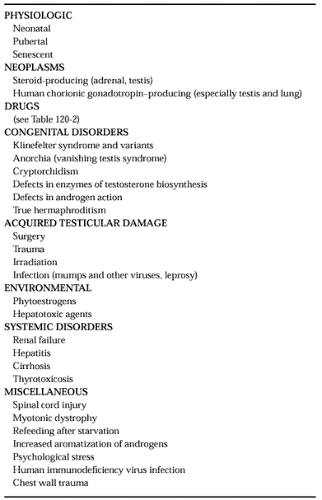GENERAL CONSIDERATIONS
Part of “CHAPTER 120 – GYNECOMASTIA“
Gynecomastia (enlargement of the male breast secondary to an increase in glandular tissue and stroma) can be a vexing clinical problem.1,2 and 3 Often, it is a benign finding, but sometimes it is an important clue to disease elsewhere4 (Table 120-1). Thus, the condition cannot be dismissed as a simple cosmetic defect, although, in a substantial number of cases, no underlying cause is ever found.
On physical examination, it is necessary to distinguish between pseudogynecomastia, which is breast enlargement caused by increased adipose tissue, and true gynecomastia (Fig. 120-1). In the latter condition, there is enlargement of the mammae. The glandular tissue can be palpated as radially arranged cords, usually around the nipple, and may form a discrete button-like mass or merge gradually with the surrounding adipose tissue. The areolae may be enlarged and convex, and the small areolar glands (glands of Montgomery) often are prominent. Frequently, the mammary papilla or nipple is enlarged and protuberant (Fig. 120-2). Breast tenderness (mastodynia) may be present, particularly
if the onset is recent. Although commonly bilateral and symmetric, gynecomastia of any cause may be unilateral or markedly asymmetric, either initially or throughout its course (Fig. 120-3).
if the onset is recent. Although commonly bilateral and symmetric, gynecomastia of any cause may be unilateral or markedly asymmetric, either initially or throughout its course (Fig. 120-3).
Stay updated, free articles. Join our Telegram channel

Full access? Get Clinical Tree






